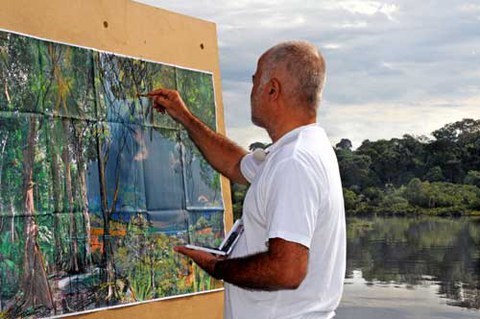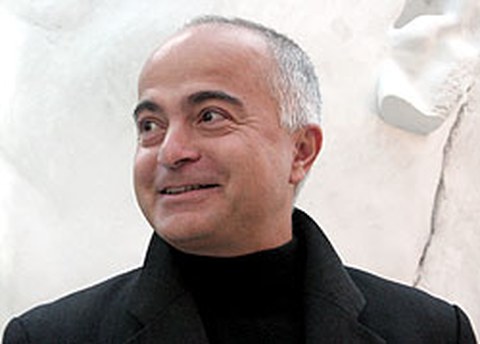Paper and pencil is all you need
(Interview from 2008)
Dagmar Möbius
In March of next year (2009 – ed.), Yadegar Asisi will open his new epic 360° panorama project AMAZONIA in the Asisi Panometer in Leipzig. He spent weeks researching for the project in Brazil. Asisi is on a tight schedule up until the opening, and he can only give an interview in his Berlin studio – "because I can draw while talking."

Yadegar Asisi is the May 2021 Alumnus of the Month
Born in Vienna in 1955, he has enjoyed drawing for as long as he can remember. To understand why he was born in Austria, of all places, we need to delve a little into the history of Iran. Asisi's father was a member of the Iranian Communist Party and remained in the party when it became illegal in the 1940s. One of 40 officers who belonged to a clandestine cell in the Iranian army, he was sentenced to death and executed by the last shah.
"My mother was left on her own with five children and pregnant with me; I was born on the run," Asisi says. From Vienna, they traveled to Warsaw and on to the GDR, to Halle. The authorities there didn't really know how best to deal with the Iranian immigrants, and put up the women and children in a villa. "Two rooms for six children, and we even had a cook for everyone, just imagine!" Asisi still marvels at the situation today. Later, each family got its own apartment, and for Asisi's family, that meant moving to Leipzig. That is where he attended school until his high school graduation.
He would have loved to become an artist right away. "But I had such a high regard for art that I lacked the courage," he recalls. At that point, his sister was studying architecture at TU Dresden. Asisi thought the mixture of drawing and painting could be a substitute for art, and came to Dresden in 1973. "In the first two years I didn't do anything. I hadn't grasped what university meant and spent more time partying. Only after those two years did I really get started," he admits. But then with such zeal that some former peers still remembered at the recent 30th anniversary celebrations for their graduating year.

Asisi painting in the Amazon
Asisi himself, with his engineering certificate in his pocket, did not feel confident as an architect and decided that he would "never do architecture until I knew what good architecture was." In retrospect, he believes the 1970s were a hostile time for architecture, and that this was not a GDR phenomenon. "Build conventional residential blocks with passageways between them to house 1000 people, and those people get lonely," he says. Nevertheless, he appreciates the training he received at TU Dresden as a solid foundation, because it was very technical.
After completing his degree in 1978, he was asked to leave the GDR within one month. "That's the point of immigration, to get an education and then return home," he explains. However, he was not allowed to enter Iran either, and so decided to go to West Berlin. There was an incident at the border. He was detained and accused of illegal entry with an Iranian passport. He could only stay if he studied, he was told. "But I have just finished studying," Asisi objected, until he saw the situation as a twist of fate. He used the opportunity and in 1984, he graduated with a degree in painting from the Hochschule der Künste (University of the Arts) in Berlin, with Meisterschüler ("masterclass student") status.
While studying, he worked for the renowned architectural firm Brandt-Asisi-Böttcher. "Engaging with content and form broadened my horizons and gave me a more relaxed attitude toward social conditions," says Asisi, who also lived in Iran for a year. The list of his projects and awards is a long one: set designs, installations, architectural projects, and, starting in 1994, his first panoramas. He and his partners have received numerous prizes, such as the Mies van der Rohe award for the terminal station of Berlin's former maglev train line. Asisi finds influences from the East, West, and Middle East an interesting combination: "I am German, but I still have an outsider's perspective."
He has never been a revolutionary, he says, but has always spoken his mind. When he recently resigned as chair of freehand expression at the architecture department of Technische Fachhochschule Berlin, which he had held since 1996, he sparked a debate in the university sector across the country. "To me, education is about personal development; I cannot abide it when it's just learning by rote," he reasons. "I'm a teacher through and through, but the university is forcing me to engage in administrative nonsense." The fact that 90 to 95 percent of students do what the professor wants upsets the artist in Asisi. "I am your sparring partner; you can't become little Asisis," he tells them, encouraging them to oppose him and argue with him. In his view, a lot needs to change in the education system, for only the reliable, trustworthy and socially competent will be successful in their careers. Being good in your field is essential, but not enough. What Asisi will do alongside his artistic commitments after his farewell lecture in Berlin in mid-January remains to be seen. But one thing is clear: "Dresden has not heard the last of me." He can see himself giving workshops and lectures. Nothing specific has been decided yet.

Yadegar Asisi
He finds the present exciting. "A crisis is better than a war" is his firm belief when he looks at the current economic situation. Asisi knows what he's talking about. After his "Everest" panorama, he was sick, and bankrupt. "Fortunately, however, I have children, and as soon as I have a piece of paper and a pencil, I'm fine; I'm happy." Nonetheless, Asisi never has the feeling that he has to work. "Everything flows" – even when he sits painting for 14 to 16 hours a day on little sleep. A Bulgarian peer in Dresden once taught him a useful trick. "Anywhere I work has to have a couch. I take a short nap during the day, and after five minutes, I'm up and ready to go again. Nowadays, it's called a power nap," he laughs.
In the final stages of completing his Amazon panorama, he swears by his team. "They are good people. Like me, they need a sense of purpose in their work," enthuses Asisi, often referred to as the "architect of illusions." There are not currently any TU Dresden graduates at his company, but that could quickly change, he says. "Those who work here enjoy taking inspiration home with them each day," claims their artistic director. "Mechanically ticking off tasks is not my thing," he concludes. And he drew throughout our conversation.
Yadegar Asisi is still happy with pencil and paper. Visitors to his panoramas can feel this as they are drawn in to views of Rome, medieval Dresden or, soon, the Amazon rainforest.
2021 update:
Asisi did not let up after the great success of AMAZONIA at the Leipzig Panometer. Many other projects followed, and his dream of a series of panoramas came true. The small atelier became a studio operating throughout Europe, which now displays Yadegar Asisi's panoramas at eight locations in Germany and France. Since 2015, Dresden has hosted two of Asisi's works in its own Panometer: baroque Dresden, and the anti-war project DRESDEN 1945, which depicts the city at zero hour in the immediate aftermath of the fateful bombing in February 1945. The subject of war, and how we deal with it, continues to preoccupy him. That is why his upcoming project NEW YORK 9/11 focuses on one of the most defining moments of violence of our era. However, the panorama does not depict the tragic events of the terrorist attack on the World Trade Center itself. Instead, it presents the silhouette of Manhattan with the world-famous Twin Towers immediately before the attacks. A typical morning in the routine of the multicultural metropolis of New York. In contrast to this scene, the route into the panorama takes you through the global consequences of that fateful day.
The current project at the Panometer Leipzig, on the other hand, is dedicated to what at first glance appears to be a local theme: CAROLA'S GARDEN is all about nature on our doorstep. A supposedly ordinary place like a typical German allotment is transformed before the visitor's eyes into an exotic biotope with fascinating plants and animals, and their larger-than-life depiction make the viewer seem tiny. Alongside the panorama, a local garden enlarged a hundredfold, there is also an exhibition of other artistic works by Asisi: around 100 watercolors, sketches, acrylic paintings, and photographs.
In addition to his major panorama projects, Asisi still makes time for his greatest passion: drawing. You can now find him as an established teacher on YouTube, where he teaches the eager student drawing, and in particular perspective, in his "sehen&gestalten" videos. In short, Yadegar Asisi is eager to share his love of pencil and paper.
Contact:
Asisi Visual Culture GmbH
Prof. Yadegar Asisi
Oranienplatz 2
10999 Berlin
Tel: 030 6958086-0
Email: Yadegar Asisi
Website: Asisi
